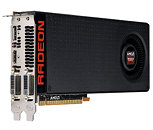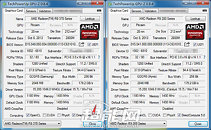Tuesday, July 28th 2015

AMD Readies Radeon R7 370X to Counter GeForce GTX 950
AMD is reportedly giving final touches to the Radeon R7 370X, to preempt launch of NVIDIA GeForce GTX 950. The card will be based on the "Trinidad XT" silicon, and will max out components physically present on the chip. This means that the card will feature 1,280 Graphics CoreNext stream processors, 80 TMUs, 32 ROPs, and a 256-bit wide GDDR5 memory interface, holding 2 GB or 4 GB of memory. Leaked screenshots that disclose these specs suggest that AMD will carry over clock speeds from the R9 270X, working out to 1180 MHz core, and 5.60 GHz (GDDR5-effective) memory, working out to a memory bandwidth of 179.2 GB/s.
Sources:
VideoCardz, Expreview


34 Comments on AMD Readies Radeon R7 370X to Counter GeForce GTX 950
The original line up never shows a card naming R9 370 Series so it should be R7 370 Series I think...
In the end, it makes little difference I suppose, it's still a recycled three-and-a-half-year-old card with little marketing appeal - no FreeSync support, nor TrueAudio ( if TrueAudio is still a thing that is).
Still, Nano is still to show so perhaps innovation (of sorts) there will he a bit more appealing.
270 retailed for 179$ back in 2013
Then again if this is more castrated tonga, it could be competitive vs nvidia's offerings.
Edit:Yes, lower clocked same chip pitcairn hd7870 is all ready fair amount faster than hd5870:
www.techpowerup.com/reviews/AMD/HD_7850_HD_7870/26.html
I would like to see if the card has evolved at all, would be nice to see theses things in OC models being around 1300mhz.
Isn't the entire point of adaptive sync to eliminate tear at less than optimal frame rates (40-60 on a 60hz?). On a 144hz monitor, what would your cards need to run at? Or is it simply that above 60fps will cause tearing regardless, so 144hz is the next step? So if your cards can output 90fps, you'd need the 144 refresh to drop down to match the 90fps, something a 60hz monitor can't attain?
If your constantly changing FPS dropping by significant amounts while shooting for 60hz, it would be helpful to a point as well but below a certain point the tech starts to lose its powers as well which then would show the need for more GPU power (besides poor game optimization which could also be a flaw). That is the way I view these techs at least.
But as long as the end user gets to see performance, all these doesn't matter really. We just have to see how well 370X can do with 950 (and 950 Ti too perhaps). But do expect to see some raging fury (I don' mean perfo'mance) from these GPU - provided coming with such high clocks.
If you are looking at $150 middle/high 1080p gaming card, most aren't gravitating toward every wiz-bang feature, or obscure codedecs, all you want is BfB and for that… we'll wait and see.
A boost clock of 1080Mhz stock would be nice, still not the 1100Mhz of the likes of PowerColor 270X PCS+; that PCS+ had 1425MHz (5.7Gbps) memory. I sure hope AMD bumps the memory up to something like 1500Mhz (6.0Gbps), I'd think sourcing better memory might be cost effective at this point.
The problem that AMD is showing itself to be more and more incapable of releasing good and profitable products. The only reason they are re-releasing this chip is because they don't have anything better, all their effort was put in Fiji, which still is a half-assed product in many ways... It uses exactly the same base architecture as the HD 7000 series. You can say exactly the same for their CPU archs... Nothing really new since FX release, which was so bad that they had to FIX the architecture for the 8350, etc. And don't come telling me that anything since the FX-8350 is a new architecture because it might as well be saying Broadwell is a new architecture, it's not.
Sure, I might buy an AMD card in the near future because of the low cost, but I would not be at all willing to invest a single penny in them. Not for the forseeable future, and definitely not before Zen is released, and only then if Zen really shows progress beyond just better price/performance.
I'm quite curious as to what exactly is allowing those chips to be much faster